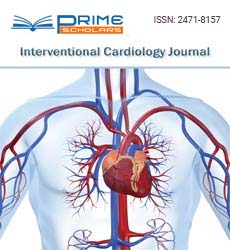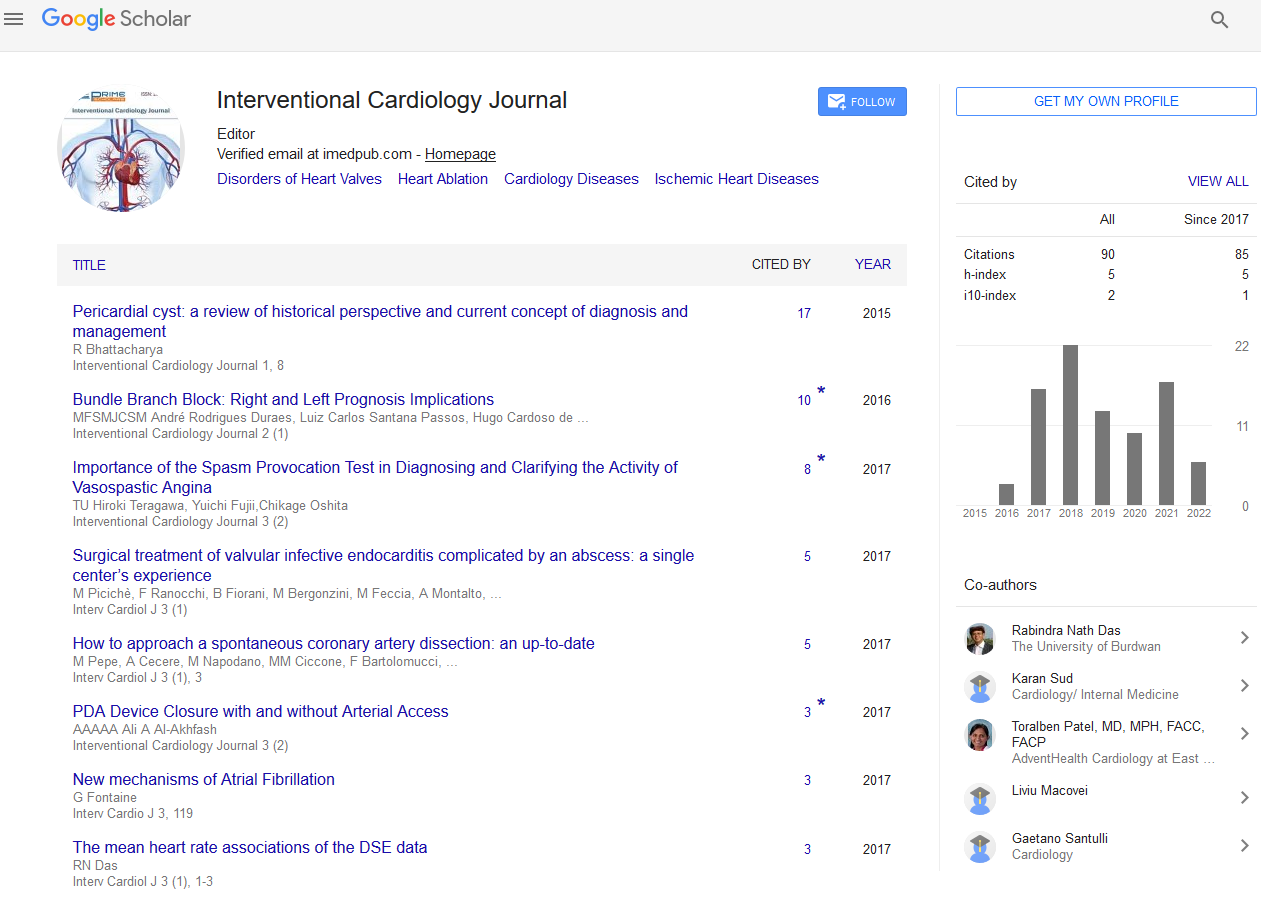Editorial - (2023) Volume 9, Issue 7
Unconstrained Coronary Artery Dissection: Clinical Considerations in Diagnosis and Treatment
Arnaldo Cantanizam*
Department of Cardiology, United Arab Emirates University, Abu Dhabi, United Arab Emirates
*Correspondence:
Arnaldo Cantanizam, Department of Cardiology, United Arab Emirates University, Abu Dhabi,
United Arab Emirates,
Email:
Received: 31-Dec-2021, Manuscript No. IPIC-21-12226;
Editor assigned: 03-Jan-2022, Pre QC No. IPIC-21-12226 (PQ);
Reviewed: 17-Jan-2022, QC No. IPIC-21-12226;
Revised: 10-Oct-2022, Manuscript No. IPIC-21-12226(R);
Published:
17-Oct-2022, DOI: 10.21767/2471-8157.9.7.69
Editorial
Unconstrained coronary conduit analyzation (SCAD) is a
special clinical substance and a significant reason for
myocardial localized necrosis (MI), especially among youthful
and moderately aged ladies. SCAD is characterized as a noniatrogenic,
non-horrible partition of the coronary corridor
divider, not related with atherosclerosis. The overwhelming
system of myocardial injury is coronary supply route check
brought about by an Intramural Hematoma (IMH) or intimal
interruption compromising the genuine lumen at the site of
dissection. The first examinations involved SCAD as the reason
for intense coronary disorder in 0.1% to 4% of cases, however
later investigations have demonstrated SCAD to be the basic
reason for MI in 22-43% of ladies <50 years. Albeit amazing
headway has been made in our comprehension of SCAD
lately, a huge extent of patients keep on being misdiagnosed
and inappropriately treated. Here we sum up the exceptional
contemplations in the conclusion and the executives of SCAD
with an emphasis on interventional treatment. Early and exact
conclusion of SCAD is fundamental in light of the fact that the
administration procedure utilized in this condition altogether
contrasts from that of atherosclerotic disease. Because
patients with SCAD are for the most part more youthful and
have less ordinary cardiovascular danger factors, they are
frequently more inclined to misdiagnosis. Coronary
angiography is the principal line demonstrative device for
patients giving intense coronary condition because of
suspected SCAD and ought to be proceeded as soon as could be
expected. Pathognomonic angiographic elements of SCAD might
incorporate different radiolucent lines, contrast staining,
bogus lumen appearance, and late difference clearing,
which are all demonstrative of intimal tear (type 1
angiographic SCAD). Intracoronary imaging techniques like
optical soundness tomography or intravascular ultrasound can fill in as a significant instrument in expanding the
demonstrative yield when there is vulnerability on coronary
angiography, particularly for cases because of IMH without
intimal tear (types 2 (long diffuse narrowing) or 3 (mimics
atherosclerosis) SCAD). Suitable patient determination is
significant while considering the utilization of intracoronary
imaging in presumed SCAD patients given the little yet
genuine danger of proliferating the analyzation or causing
guide catheter actuated analyzation. Also, extreme attention
to detail and fastidious methods ought to be utilized once the
choice is made to perform. A scarcity of information exists in
regards to ideal administration of SCAD because of absence of
randomized preliminaries contrasting clinical treatment and
revascularization methodologies. Observational information
has shown that when rehash angiography is performed,
70%-97% of safely overseen patients showed
angiographic recuperating of SCAD sores. Accordingly,
a moderate treatment procedure is suggested much of the
time, which incorporates a lengthy ongoing checking time of
3-5 days. The foundation of long haul clinical treatment in
SCAD is a mix of headache medicine and beta blocker. Beta
blocker use has been related with a lower hazard of
intermittent SCAD (peril proportion 0.36) and is consequently
a fundamental piece of long haul treatment at our
foundation. A point by point conversation of clinical
treatment in SCAD is accessible in an as of late distributed
survey. Revascularization for SCAD ought to be considered in
patients showing dynamic myocardial ischemia,
hemodynamic shakiness, or left fundamental analyzation,
in which moderate administration is an unsuitable
other option. Coronary supply route sidestep joining a
medical procedure (CABG) ought to be saved for patients
with left primary or multiverse proximal enormous vessel
analyzation, particularly in the setting of hemodynamic trade off. Intravascular imaging can give interesting
morphological and physical subtleties that can be utilized to
keep away from specific specialized challenges. For instance,
optical intelligibility tomography can affirm situating of the
angioplasty wire in the genuine lumen and can precisely limit
the intimal disturbance site and full degree of IMH,
consequently working with right stent estimating and sending.
Limiting inflatable expansions or direct stents may likewise
diminish the danger of IMH augmentation. Additionally, swell
angioplasty alone may likewise be utilized to re establish
coronary stream. A cutting inflatable system can likewise be utilized trying to de pressurize the blood in the bogus lumen
into the genuine lumen. Cutting inflatable angioplasty ought
to be perform circumspectly utilizing a small inflatable. There
is restricted information on the viability of these PCI
strategies.
Citation: Cantanizam A (2023) Unconstrained Coronary Artery Dissection: Clinical Considerations in Diagnosis and Treatment. Interv Cardiol J. 9:57.
Copyright: © 2023 Cantanizam A. This is an open-access article distributed under the terms of the Creative Commons Attribution License, which permits unrestricted use, distribution, and reproduction in any medium, provided the original author and source are credited.

